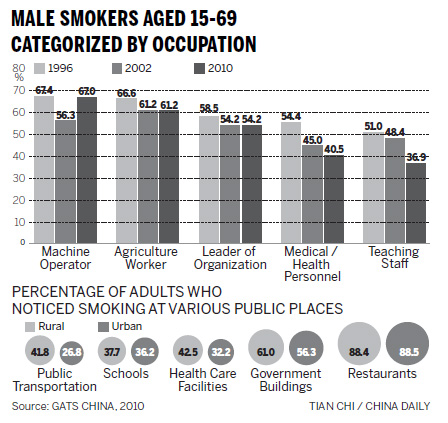Secondhand smoke levels up
A tobacco usage survey of Chinese people released on Tuesday shows a big increase in the rate of exposure to secondhand smoke among Chinese people. The rate jumped from 53 percent in 2002 to about 73 percent in 2010.
![A boy lights a cigarette for his father on May 26 in Shaoyang, Hunan province. [China Daily] A boy lights a cigarette for his father on May 26 in Shaoyang, Hunan province. [China Daily]](http://images.china.cn/attachement/bmp/site1007/20100818/0019b93bd68d0dd57dab01.bmp) |
|
A boy lights a cigarette for his father on May 26 in Shaoyang, Hunan province. |
The survey in China done by Chinese Center for Disease Control and Prevention (CDC) was conducted from December last year through March, covering more than 13,000 people over the age of 15.
"If no improvement is made, the deaths due to smoking in China will grow to 2 million by 2030 and it will keep increasing to 3 million in 2050," Yang said.
"There is no safe level of exposure to secondhand smoke. If non-smoking areas are not completely separated from the smoking areas, the harm to our health will be the same," said Zhi Xiuyi, a professor at the Capital Medicine University.
Zhu Lanting, a 35-year-old housewife living in Futian, Shenzhen, said that her husband, who is a machine operator, started to smoke when he was 18 and now always smokes at home.
"We have two children, the younger boy is 1-year-old. I never stop him from smoking at home. We have already gotten used to it and so have many of my female friends who have husbands who smoke. I believe we are safe and my husband never thinks about quitting," she said.
Looking at male smokers by occupation, 55 percent of leaders of organizations and more than 40 percent of medical health personnel are smokers. The rate is only slightly lower than the rate of machine operators and agriculture workers.
"Medical treatment is essential to quit smoking. But doctors have to quit smoking first to build a good image and then popularize the knowledge of going tobacco free," Zhi said.
Nearly 770 million non-smokers are exposed to secondhand smoke, the survey said.
"It seems that little improvement was made in the exposure to secondhand smoke," said Yang Gonghuan, director of the tobacco control office of the CDC.
According to the survey, more than 58 percent of non-smokers noticed smoking in government buildings, which ranked second in the type of buildings that had public smoking. Restaurants were in first place.
 |
"The exposure rate in China is increasing sharply and the number is amazing," said Douglas Bettcher, director of the WHO Tobacco Free Initiative.
The Ministry of Health announced in May this year that smoking will no longer be allowed inside the ministry building as of May 31, which was believed to be a step toward implementing the WHO Framework Convention on Tobacco Control (FCTC). China joined the FCTC in 2005. Under the convention, all member countries are obliged to undertake a comprehensive ban on tobacco in public places by 2011.
"It's a new step toward going tobacco free in China. But the fact is the law in the country is still weak and many people are not even aware of the harm of being exposed to secondhand smoke, especially those without much education," Bettcher said.
The statistics from the WHO show secondhand smoke kills 600,000 people around the world. The number in China is estimated at 100,000.
 0
0 







Go to Forum >>0 Comments